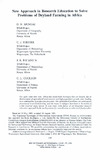New Approach in Research Education to Solve Problems of Dryland Farming in Africa

View/
Date
1996Author
Stigter, CJ
Ng'ang'a, JK
Mungai, DN
Coulson, CL
Type
ArticleLanguage
enMetadata
Show full item recordAbstract
For quite some time now, Africa has faced food shortages that are largely due to
deterioration of agricultural environments and high population growth rates, leading
to a combination of production pressures. The agricultural problems are particularly
pronounced in dryland farming, and the means to mitigate them have to be mainly of
a low external input nature. A case study from Kenya of an integrated research
education approach holds much promise for contributions to solve such food production problems in the dry lands of Africa and other low external input sustainable
agriculture (LEISA). The approach emphasizes interdisciplinary research education of
local scientists by problem-oriented research in tackling environmental hazards facing
the farmers. Six primary sequential steps, from problem identification via field quantification
to the contributions to solutions, are distinguished as essential. In the Kenyan
example, it was possible to give a "weather advisory, " that is, an extension message
with strong agroclimatological components, on the biophysical and economic limits of
alley cropping Cassia siamea with maize in a semiarid environment. Adaptation requirements
of some commercial instruments under tropical conditions were also covered.
Such a range of subjects is essential if research education is to contribute to
protection from environmental hazards in dryland farming.
Citation
Arid Soil Research and Rehabilitation, 10:169-177, 1996Publisher
University of Nairobi. Department of Botany University of Nairobi Kenya, Africa
